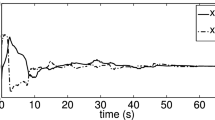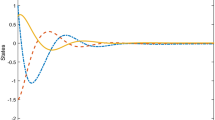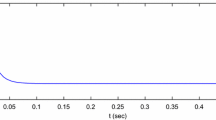Abstract
In this paper, we consider the robust non-fragile \(H_{\infty }\) fuzzy control for uncertain nonlinear delayed hyperbolic partial differential equation (PDE) systems, which can represent the dynamics of most industrial processes, such as plug-flow reactors, fixed-bed reactors, tubular heat exchangers, traffic flows, and wave equations. Initially, a Takagi–Sugeno (T–S) fuzzy-delayed hyperbolic PDE model is presented to describe the uncertain nonlinear delayed hyperbolic PDE system. Subsequently, based on the T–S fuzzy delayed hyperbolic PDE model, spatial linear matrix inequality (SLMI) based sufficient conditions to ensure exponential stability with an \(H_{\infty }\) performance are obtained via utilizing the Lyapunov direct method. Then, to solve the SLMIs, the robust non-fragile \(H_{\infty }\) fuzzy control problem for uncertain nonlinear delayed hyperbolic PDE systems is formulated as an LMI feasibility problem. Finally, two examples on a Lotka–Volterra PDE system and a non-isothermal plug-flow reactor (PFR) are presented to illustrate the effectiveness of the presented control method.







Similar content being viewed by others
References
Liang, M., Chang, Y., Zhang, F., Wang, S., Wang, C., Lu, S., Wang, Y.: Observer-based adaptive fuzzy output feedback control for a class of fractional-order nonlinear systems with full-state constraints. Int. J. Fuzzy Syst. 24, 1046–1058 (2022)
Song, X., Sun, P., Song, S., Wu, Q., Lu, J.: Event-triggered fuzzy adaptive fixed-time output-feedback control for nonlinear systems with multiple objective constraints. Int. J. Fuzzy Syst. (2022). https://doi.org/10.1007/s40815-022-01304-0
Takagi, T., Sugeno, M.: Fuzzy identification of systems and its applications to modeling and control. IEEE Trans. Syst. Man Cybern. 15(1), 116–132 (1985)
Tanaka, K., Wang, H.O.: Fuzzy Control Systems Design and Analysis: A Linear Matrix Inequality Approach. Wiley, New York (2001)
Feng, G.: Analysis and Synthesis of Fuzzy Control Systems: A Model Based Approach. CRC Press, Boca Raton (2010)
Ray, W.-H.: Advanced Process Control. McGraw-Hill, New York (1981)
Curtain, R.F., Zwart, H.: An Introduction to Infinite-Dimensional Linear Systems Theory. Springer, New York (1995)
Padhi, R., Ali, S.F.: An account of chronological developments in control of distributed parameter systems. Annu. Rev. Control. 33(1), 59–68 (2009)
Wang, J.-W., Wu, H.-N., Li, H.-X.: Distributed fuzzy control design of nonlinear hyperbolic PDE systems with application to nonisothermal plug-flow reactor. IEEE Trans. Fuzzy Syst. 19(3), 514–526 (2011)
Wang, J.-W., Wu, H.-N.: Fuzzy output tracking control of semi-linear first-order hyperbolic PDE systems with matched perturbations. Fuzzy Sets Syst. 254, 47–66 (2014)
Qiu, J., Ding, S.-X., Gao, H., Yin, S.: Fuzzy-model-based reliable static output feedback \(H_{\infty }\) control of nonlinear hyperbolic PDE systems. IEEE Trans. Fuzzy Syst. 24(2), 388–400 (2016)
Fridman, E., Orlov, Y.: An LMI approach to \(H_{\infty }\) boundary control of semilinear parabolic and hyperbolic systems. Automatica 45(9), 2060–2066 (2009)
Wu, H.-N., Wang, J.-W., Li, H.-X.: Design of distributed \(H_{\infty }\) fuzzy controllers with constraint for nonlinear hyperbolic PDE systems. Automatica 48(10), 2535–2543 (2012)
Tsai, S.-H., Wang, J.-W., Song, E.-S., Lam, H.-K.: Robust \(H_{\infty }\) control for nonlinear hyperbolic PDE systems based on the polynomial fuzzy model. IEEE Trans. Cybern. 51(7), 3789–3801 (2021)
He, Y., Wang, Q.-G., Xie, L.H., Lin, C.: Further improvement of free-weighting matrices technique for systems with time-varying delay. IEEE Trans. Autom. Control 52(2), 293–299 (2007)
Seuret, A., Gouaisbaut, F.: Wirtinger-based integral inequality: application to time-delay systems. Automatica 49(9), 2860–2866 (2013)
Fridman, E., Orlov, Y.: Exponential stability of linear distributed parameter systems with time-varying delays. Automatica 45(1), 194–201 (2009)
Wang, J.-W., Sun, C.-Y.: Delay-dependent exponential stabilization for linear distributed parameter systems with time-varying delay. J. Dyn. Syst. Meas. Control 140(5), 051003 (2018)
Wu, H.-N., Zhang, X.-W.: Static output feedback stabilization for a linear parabolic PDE system with time-varying delay via mobile collocated actuator/sensor pairs. Automatica 117, 108993 (2020)
Yuan, K., Li, H.-X., Cao, J.: Robust stabilization of the distributed parameter system with time delay via fuzzy control. IEEE Trans. Fuzzy Syst. 16(3), 567–584 (2008)
Chang, Y.-T., Chen, B.-S.: A fuzzy approach for robust referencetracking-control design of nonlinear distributed parameter time-delayed systems and its application. IEEE Trans. Fuzzy Syst. 18(6), 1041–1057 (2010)
Wang, Z.-P., Wu, H.-N., Huang, T.: Sampled-data fuzzy control for nonlinear delayed distributed parameter systems. IEEE Trans. Fuzzy Syst. 29(10), 3054–3066 (2021)
Zhang, X.-W., Wu, H.-N.: Fuzzy control design of nonlinear time-delay parabolic PDE systems under mobile collocated actuators and sensors. IEEE Trans. Cybern. 52(5), 3947–3956 (2022)
Wang, Z.-P., Wu, H.-N., Huang, T.: Spatially local piecewise fuzzy control for nonlinear delayed DPSs with random packet losses. IEEE Trans. Fuzzy Syst. 30(5), 1447–1459 (2022)
Wang, Z.-P., Zhang, X., Wu, H.-N., Huang, T.: Fuzzy boundary control for nonlinear delayed DPSs under boundary measurements. IEEE Trans. Cybern. (2021). https://doi.org/10.1109/TCYB.2021.3105249
Chen, W.-H., Wang, Z., Wei, D., Lu, X.: Robust sampled-data \(H_{\infty }\) control of uncertain singularly perturbed systems using time-dependent lyapunov functionals. Int. J. Syst. Sci. 46(15), 2832–2852 (2015)
Wang, J.-W., Wu, H.-N., Li, H.-X.: Distributed proportional-spatial derivative control of nonlinear parabolic systems via fuzzy PDE modeling approach. IEEE Trans. Cybern. 42(3), 927–938 (2012)
Gahinet, P., Nemirovski, A., Laub, A.J., Chilali, M.: LMI Control Toolbox. MathWorks, Inc., Natick (1995)
Levine, I.N.: Quantum Chemistry. Prentice Hall International, Inc., New York (2009)
Wang, J.-W., Wu, H.-N.: Design of suboptimal local piecewise fuzzy controller with multiple constraints for quasi-linear spatiotemporal dynamic systems. IEEE Trans. Cybern. 51(5), 2433–2445 (2021)
Aksikas, I., Winkin, J.J., Dochain, D.: Optimal LQ-feedback regulation of a nonisothermal plug flow reactor model by spectral factorization. IEEE Trans. Autom. Control 52(7), 1179–1193 (2007)
Acknowledgements
This work was supported in part by the National Key Research and Development Program of China under Grants 2021ZD0112301 and 2021ZD0112302, in part by the National Natural Science Foundations of China under Grants 62073011, 62203326, and 61973135 and in part by the Shandong Provincial Natural Science Foundation under Grant ZR2021MF 004.
Author information
Authors and Affiliations
Corresponding author
Appendices
Appendix 1
Differentiating V(t) along the solution of the system (9) yields
Integrating by parts in (35), we obtain
where \(\vartheta (x)\) is the Dirac delta function defined as follows:
and has the following property:
From (36), one has the following equality considering \(P(x){\varTheta }(x)={\varTheta }^T(x)P(x)\):
with \(\xi (x,t)=[ \ z^T(x,t) \ z^T(x,t-\tau (t)) \ z^T(z,t-{\bar{\tau }}) \ ]^T\).
It is shown from (38) that if the following matrix inequalities hold:
with
Then the closed-loop fuzzy delayed hyperbolic PDE system (13) is exponentially stable with a decay rate \(\delta\).
Define \(Q(x)\triangleq P^{-1}(x)\), \({\tilde{K}}_j(x)\triangleq K_j(x) Q(x)\), \({\bar{Q}}_1(x)\) \(\triangleq Q(x)Q_1(x)Q(x)\), and \({\bar{Q}}_2(x)\triangleq Q(x)Q_2(x)Q(x)\). Pre- and postmultiplying both sides of \({\varPsi }_{ij}(x)\) by \(\text {diag}\{Q(x)\)\(Q(x), Q(x)\}\) and using the property \(Q_x(x)=-Q(x)\)\(Q^{-1}_x(x)Q(x)\). Subsequently, by Lemma 2, we can obtain Theorem 1. \(\square\)
Appendix 2
From (9), (10), and (35), we have
Defining \({\bar{\xi }}(x,t)=[ \ z^T(x,t) \ z^T(x,t-\tau (t)) \ z^T(z,t-{\bar{\tau }}) \ w^T(x,t) \ ]^T\), one has
where
with
Using Lemma 1, one has
With the help of Lemma 1, the terms \(D{\varDelta } K_j(x,t)\) and \(E_{3i}{\varDelta } K_j(x,t)\) in (41) can be solved by parameters \(\iota _{ij}\) and \(\kappa _{ij}\), respectively. Then, from (39)–(41) and using Schur complement, the matrices \({\varPhi }_{ij}(x)\) in (40) can be transformed as follows:
with
It is obvious that the inequality is ensured as follows:
if
Pre- and post–multiplying both sides of \({\varLambda }_{ij}(x)\) by diag \(\{Q(x), Q(x), Q(x), I, I, \varsigma _{ij}I, I, \sigma _{ij}I, I, \varrho _{ij}I, I, \rho _{ij}I, I\), \(\theta _{ij}I, I, I, I, I, I\}\) and using the property \(Q_x(x)=-Q(x)\)\(Q^{-1}_x(x)\) Q(x). Then, by Lemma 2, we can obtain Theorem 2. \(\square\)
Rights and permissions
Springer Nature or its licensor holds exclusive rights to this article under a publishing agreement with the author(s) or other rightsholder(s); author self-archiving of the accepted manuscript version of this article is solely governed by the terms of such publishing agreement and applicable law.
About this article
Cite this article
Zhang, X., Wang, ZP., Wu, HN. et al. Robust Non-fragile \(H_{\infty }\) Fuzzy Control for Uncertain Nonlinear-Delayed Hyperbolic PDE Systems. Int. J. Fuzzy Syst. 25, 851–867 (2023). https://doi.org/10.1007/s40815-022-01409-6
Received:
Revised:
Accepted:
Published:
Issue Date:
DOI: https://doi.org/10.1007/s40815-022-01409-6




